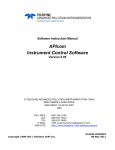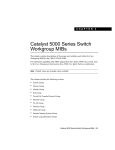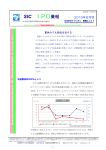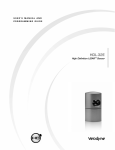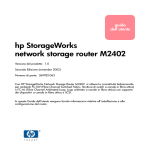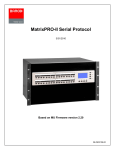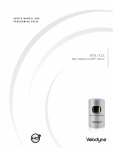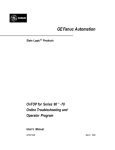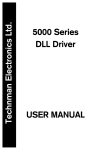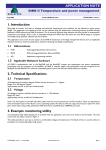Download Multicon User manual
Transcript
Multicon SNMP Data Model Multicon SNMP Data Model User manual Rev. 0 Nevion Europe AS P.O. Box 1020, 3204 Sandefjord, Norway – Tel: +47 33 48 99 99 – Fax: +47 33 48 99 98 www.nevion.com Multicon SNMP Data Model Rev. 0 Nevion Support Nevion Europe Nevion USA P.O. Box 1020 3204 Sandefjord, Norway Support phone 1: +47 33 48 99 97 Support phone 2: +47 90 60 99 99 1600 Emerson Avenue Oxnard, CA 93033, USA Toll free North America: (866) 515-0811 Outside North America: +1 (805) 247-8560 E-mail: [email protected] See http://www.nevion.com/support/ for service hours for customer support globally. Revision history Current revision of this document is the uppermost in the table below. Rev. Repl. Date Sign 0 - 20090702 JIH Change description First official release nevion.com | 2 Multicon SNMP Data Model Rev. 0 Contents Revision history........................................................................................................ 2 1 Product overview .................................................................................................. 4 2 Data model .......................................................................................................... 5 2.1 High-level overview ......................................................................................................... 5 2.2 Current MIB structure – nworktwo .................................................................................. 6 2.3 Block functions – module ................................................................................................ 7 2.4 Block addressing – module .............................................................................................. 7 2.5 VikinX router control – level............................................................................................. 8 2.6 Flashlink router matrix control – level .............................................................................. 8 2.7 Generic tree - generic ...................................................................................................... 8 3 Notifications ......................................................................................................... 9 4 Data model overview .......................................................................................... 10 General environmental requirements for Nevion equipment .................................. 12 Product Warranty .................................................................................................. 13 nevion.com | 3 Multicon SNMP Data Model Rev. 0 1 Product overview Multicon is the next-generation element manager for Flashlink system and system controller for VikinX range of routers. The product is based on a new open and distributed architecture and enables customers to deploy one control system for both Flashlink and VikinX. The new product offers a range of important improvements for router control and also supports control panel access to Flashlink parameters, which is increasingly important for signal processing and distribution applications. For a more detailed overview of the Multicon product refer to the main manual. This document describes the SNMP interface provided by Multicon for monitoring and configuration of Flashlink systems and VikinX routers. nevion.com | 4 Multicon SNMP Data Model Rev. 0 2 Data model 2.1 High-level overview The figure below gives an overview of the hierarchy of the MIB model implemented for Flashlink and VikinX. Deprecated Figure 1: High-level MIB structure The MIB structure is located under the enterprise OID iso.org.dod.internet.private.enterprises.nwork.products (1.3.6.1.4.1.8768.1). The structure beneath products (1) is described below: • flashlink (1): deprecated and should not be used, only included for backwards compatibility with older Flashlink cards • vikinx (2): deprecated and should not be used, only included for backwards compatibility • conquer (3): deprecated and should not be used, only included for backwards compatibility with older Flashlink SP&D cards • nworktwo (4): currently supported MIB structure for both Flashlink systems and VikinX routers Note that it is not necessary to use the flashlink (1), vikinx (2) and conquer (3) MIB structures for new implementations as older Flashlink equipment and VikinX routers is also supported by the currently supported MIB structure under nworktwo (4). nevion.com | 5 Multicon SNMP Data Model Rev. 0 2.2 Current MIB structure – nworktwo The figure below gives an overview of the nworktwo (4) MIB structure that is currently supported for Flashlink systems and VikinX routers. Figure 2: nworktwo (4) MIB structure The currently supported MIB structure for Flashlink systems and VikinX routers is located under the enterprise OID iso.org.dod.internet.private.enterprises.nwork.products.nworktwo (1.3.6.1.4.1.8768.1.4). The structure beneath nworktwo (4) is described below: nevion.com | 6 Multicon SNMP Data Model Rev. 0 • bus (1): includes busSysType and busNum parameters that is used as index for tables under netInterface (2), router (3), gydaBus (4) and module (5) • netInterface (2): not in use • router (3): includes table with general information about managed routers • gydaBus (4): for internal use only • module (5): this is the most important part of the MIB structure for Flashlink systems, which includes tables corresponding to logical functions of each module. Note that a module here is either a Flashlink card or a VikinX router. • partition (6): deprecated and should not be used, includes partition info for VikinX routers. • level (7): this part of the MIB structure is used for controlling levels and cross-point settings for VikinX routers, but also for controlling matrixes in Flashlink. • event (8): not in use 2.3 Block functions – module Each table in the MIB corresponds to a logical function on the card it belongs to. Any card may have any number of each type of block, depending on the type of card. Each table contains a superset of attributes for each function block, thus there is likely to be unimplemented attributes for most blocks. In a future version of Gyda/Multicon, attributes will be filtered so that only relevant attributes are presented. For reference to the description for each table within the module tree please refer to the description within the MIB file itself. Example: cableEQTable OBJECT-TYPE SYNTAX SEQUENCE OF CableEQEntry ACCESS not-accessible STATUS mandatory DESCRIPTION "The cableEQTable lists all cableEQs for those modules that have them. A module can have zero or more cableEQs." ::= { module 5 } This tells you that this is a table containing all cable equalizers in the system. 2.4 Block addressing – module Any number of function block of any time may reside on any single card, so the data model is designed for flexibility. Every block is addressed with a 4-dimensional index, although in practice only two of these dimensions are in use for any controller. The busSysType parameter is always 2 (gyda) for Flashlink cards, and busNum is usually 1 for Flashlink cards. This may have been changed in configuration of the Gyda controller. The last two indices are in active use. moduleNum matches the card position, counting index0, i.e. card position 5 in rack 0 corresponds to moduleNum = 4, position 8 in rack 4 corresponds to moduleNum = 47. The last index is uniquely named for all blocks, but is simple the address of an instance of that particular table. nevion.com | 7 Multicon SNMP Data Model Rev. 0 Example 1: NWORK-MIB::moduleAlarmCount.gyda.1.4 = INTEGER: 1 NWORK-MIB::moduleAlarmCount.gyda.1.6 = INTEGER: 5 This shows the module alarm count for Flashlink cards with moduleNum 4 and 6, which translates to cards in frame 0 slots 5 and 7. Example 2: NWORK-MIB::cableEQAlarmStatus.gyda.1.6.0 = INTEGER: notacked(3) NWORK-MIB::cableEQAlarmStatus.gyda.1.6.1 = INTEGER: notacked(3) This shows the card equalizer alarm status for Flashlink card with moduleNum 6 (frame 0 slot 7). In this case the card has two cable equalizers, which are presented with an additional index to specify the cable equalizers, in this case 0 and 1. 2.5 VikinX router control – level All globally mapped router levels, i.e. levels that are enabled through the System Configurator for Multicon, are controllable through entries in crosspointTable. levelTable gives a summary of the router level, and should be used to discover which levels are available in the system. Example: NWORK-MIB::crosspointInputNum.3.0 = INTEGER: 0 NWORK-MIB::crosspointInputNum.3.1 = INTEGER: 26 NWORK-MIB::crosspointInputNum.3.2 = INTEGER: 5 ... This shows for level 3 which input in this level the cross-point is switched to, in this case input 0 is switched to output 0, 1 to 26 and 2 to 5. 2.6 Flashlink router matrix control – level For historical reasons, router control is left outside the module addressed data tree. The card address can still be derived from the level number, as the level numbers for matrices residing in Flashlink cards are calculated from the following formula: Level = 10000 + positioncard x 10 + subindexmatrix These levels are presented in addition to the levels mapped using the System Configurator, and are only available on the controller with the physical connection to the cards. Example: NWORK-MIB::crosspointInputNum.10080.0 = INTEGER: 0 NWORK-MIB::crosspointInputNum.10080.1 = INTEGER: 0 NWORK-MIB::crosspointInputNum.10080.2 = INTEGER: 4 ... This shows level 10080 which represents the Flashlink card in position 8 with matrix index 0. In this case it is an AV-HD-XMUX de-embedder matrix. 2.7 Generic tree - generic The MIB also contains a generic tree on the same level as products iso.org.dod.internet.private.enterprises.nwork.generic (1.3.6.1.4.1.8768.4). This part of the MIB may be used for retrieving log information from Multicon. nevion.com | 8 Multicon SNMP Data Model Rev. 0 3 Notifications Multicon has the capability to send SNMP notifications (traps) when alarms occur in a Flashlink system or VikinX router. The trap types supported are listed in the MIB file. There are one trap type indicating the raise of an alarm and a corresponding trap type to indicate clear of an alarm. Each trap type contains values from the SNMP data model pertaining to the alarm situation, which enables SNMP managers to poll for more information when a trap is received. Example: nworkLossOfOptSignal TRAP-TYPE ENTERPRISE generic VARIABLES { busSysType, busNum, moduleNum, moduleLabel, optInputNum } DESCRIPTION "Loss of input signal on optical input." ::= 3 nworkCorrectOptSignal TRAP-TYPE ENTERPRISE generic VARIABLES { busSysType, busNum, moduleNum, moduleLabel, optInputNum } DESCRIPTION "Signal on optical input comes back after having been lost." ::= 4 The example above shows an loss of optical signal alarm and a corresponding clear alarm. In each case the values of busSysType, busNum, moduleNum, moduleLabel and optInputNum is sent with the trap. nevion.com | 9 Multicon SNMP Data Model Rev. 0 4 Data model overview The figure on the next page gives a total overview of the entire SNMP data model for Multicon. For reference to the description and possible values for each parameter please refer to the description within the MIB file itself. Example: moduleStatus OBJECT-TYPE SYNTAX INTEGER { ok(1), fail(2), removed(3) } ACCESS read-only STATUS mandatory DESCRIPTION "Is the module present and operating?" ::= { moduleEntry 3 } This shows that it is a read-only parameter with the possible values ok, fail and removed. A relevant description is also shown above. Note that it is highly recommended to use a MIB browser to read the MIB file as it can be very hard to read the MIB as a text file. nevion.com | 10 Multicon SNMP Data Model Rev. 0 voltageEntry videoScalerEntry PK,FK1 PK,FK1 PK,FK1 PK optAmpEntry videoScalerStatus videoScalerLinesIn videoScalerFrameRateIn videoScalerFrameStructureIn videoScalerAspectRatioIn videoScalerAspectRatioInMode videoScalerPan videoScalerTilt videoScalerLinesOut videoScalerFrameRateOut videoScalerFrameStructureOut videoScalerAspectRatioOut videoScalerAncPasthru videoScalerAlarmStatus videoScalerAlarmTrap PK,FK1 PK,FK1 PK,FK1 PK busSysType busNum moduleNum optAmpNum optAmpSignalMode optAmpGainMode optAmptControlMode optAmpGain optAmpoutput PK,FK1 PK,FK1 PK,FK1 PK busSysType busNum moduleNum videoGenNum videoGenWss videoGenLines videoGenFrameRate videoGenFrameStructure videoGenPattern videoGenY videoGenCb videoGenCr busSysType busNum busName PK,FK1 PK,FK1 PK,FK1 PK busSysType busNum moduleNum audioProcEntry PK,FK1 PK,FK1 PK,FK1 PK choBlockEntry PK,FK1 PK,FK1 PK,FK1 PK busSysType busNum moduleNum choBlockNum vadcEntry audioGenEntry busSysType busNum moduleNum colourSpaceNum busSysType busNum moduleNum audioGenNum colourSpaceEnable colourSpaceInputMode colourSpaceInput colourSpaceOutput audioGenSampleRate audioGenWordLength audioGenChannels audioGenLevel audioGenPattern audioGenFrequency serialPortEntry PK,FK1 PK,FK1 PK,FK1 PK levelEntry busSysType busNum moduleNum serialPortNum serialPortEnable serialPortStatus serialPortDatabits serialPortParity serialPortSpeed serialPortAlarmStatus serialPortAlarmTrap levelNum levelInputs levelOutputs levelName levelTypeVideo levelTypeVideoAnalogue levelTypeVideoSDI levelTypeVideoHDSDI levelTypeAudio levelTypeAudioAnalogue levelTypeAudioAES levelTypeData levelTypeDataVideo levelTypeDataAudio levelTypeTieline levelTypeTielineVideo levelTypeTielineAudio busSysType busNum moduleNum gpioNum levelNum crosspointOutputNum crosspointInputNum crosspointLocking crosspointLockUID busSysType busNum moduleNum embedderNum embedderType embedderGroup embedderStripGroup embedderWordLength embedderStatus embedderAlarmStatus embedderAlarmTrap monitorEntry PK,FK1 PK,FK1 PK,FK1 PK PK,FK1 PK,FK1 PK,FK1 PK busSysType busNum moduleNum vdacNum busSysType busNum moduleNum optInputNum cableEQConfig cableEQStatus cableEQAlarmStatus cableEQAlarmTrap syncSourceEntry PK,FK1 PK,FK1 PK,FK1 PK vdacFormat vdacMod50 vdacWss vdacWssMode vdacMod60 vdacSetup vdacLines vdacFrameRate vdacFrameStructure vdacAlarmStatus vdacAlarmTrap vdacSubCarrierPhase busSysType busNum moduleNum syncSourceNum syncSourceType syncSourceLines syncSourceFrameRate syncSourceFrameStructure syncSourceSampleRate syncSourceWordLength syncSourceAlarmStatus syncSourceAlarmtrap audioBlockEntry laserEntry cableDriverEntry PK,FK1 PK,FK1 PK,FK1 PK busSysType busNum moduleNum cableDriverNum cableDriverConfig cableDriverSlewRate PK,FK1 PK,FK1 PK,FK1 PK busSysType busNum moduleNum laserNum laserWavelength laserPower laserConfig laserStatus laserAlarmStatus laserAlarmTrap PK,FK1 PK,FK1 PK,FK1 PK busSysType busNum moduleNum monitorNum monitorType monitorSignaltype monitorSignalFormat monitorAlarmStatus monitorAlarmTrap monitorErrorCountMax monitorErrorCount monitorErrorDeltaAlarm monitorErrorCountAlarm monitorErrorFreeAlarm monitorErrorFreeCount monitorMaskVS monitorMaskFFCRC monitorMaskAPCRC monitorMaskLock monitorMaskANCS monitorMaskLCRC monitorMaskLNUM monitorMaskTRS monitorMaskFFEDA monitorMaskFFIDH monitorMaskFFIDA monitorMaskFFUES monitorMaskAPEDA monitorMaskAPIDH monitorMaskAPIDA monitorMaskAPUES monitorMaskANEDH monitorMaskANEDA monitorMaskANIDH monitorMaskANIDA monitorMaskANUES optInputStatus optInputRSSI optInputAlarmStatus optInputAlarmTrap busSysType busNum moduleNum cableEQNum rfAmpEntry crosspointEntry PK,FK1 PK PK,FK1 PK,FK1 PK,FK1 PK busSysType busNum moduleNum temperatureNum PK,FK1 PK,FK1 PK,FK1 PK cableEQEntry PK,FK1 PK,FK1 PK,FK1 PK busSysType busNum moduleNum vadcNum vadcFormat vadcWss vadcSetup vadcLines vadcFrameRate vadcFrameStructure vadcMark vadcAgc vadcFilter vadcGainR vadcGainG vadcgainB vadcLumaBrightness vadcLumaContrast vadcChromaSaturation vadcChromaHue vadcYBrightness vadcYContrast vadcPbSaturation vadcPrSaturation vadcAlarmStatus vadcAlarmTrap embedderEntry fanNominal fanSpeed fanUpperLimit fanLowerLimit fanAlarmStatus fanAlarmTrap temperatureDescription temperatureNominal temperatureValue temperatureUpperLimit temperatureLowerLimit temperatureAlarmStatus temperatureAlarmTrap reclockerConfig reclockerConfigASI reclockerLoopBW reclockerStatus reclockerBitRate reclockerAlarmStatus reclockerAlarmTrap vdacEntry colourSpaceEntry busSysType busNum moduleNum fanNum optInputEntry PK,FK1 PK,FK1 PK,FK1 PK PK,FK1 PK,FK1 PK,FK1 PK PK,FK1 PK,FK1 PK,FK1 PK busSysType busNum moduleNum reclockerNum gpioMode gpioStatus gpioDescription gpioAlarmStatus gpioAlarmTrap audioProcMode audioProcInputs audioProcOutputs choBlockSize choBlockMode choBlockRule choBlockLatch choBlockHoldTime choBlockLockTime choBlockPri1 choBlockPri2 choBlockPri3 choBlockAlarmStatus choBlockAlarmtrap PK,FK1 PK,FK1 PK,FK1 PK PK,FK1 PK,FK1 PK,FK1 PK busSysType busNum moduleNum audioProcNum PK,FK1 PK,FK1 PK,FK1 PK temperatureEntry reclockerEntry gpioEntry PK,FK1 PK,FK1 PK,FK1 PK fanEntry busSysType busNum moduleNum voltageNum voltageNominal voltageValue voltageUpperLimit voltageLowerLimit voltageAlarmStatus voltageAlarmTrap delayType delayStatus delayDescription delayFrames delayLpF delayLines delaySpL delaySamples delaySampleRate delaySeconds delayNanosecs moduleEntry PK,FK1 PK,FK1 PK PK,FK1 PK,FK1 PK,FK1 PK busSysType busNum moduleNum delayNum busSysType busNum moduleNum ethPortNum ethPortEnable ethPortSignal ethPortDuplexMode ethPortMdiMode ethPortMsMode ethPortSpeed ethPortAlarmStatus ethPortAlarmTrap PK PK PK moduleType moduleStatus moduleLabel moduleAlarmStatus moduleAlarmTrap moduleAlarmCount ethPortEntry PK,FK1 PK,FK1 PK,FK1 PK delayEntry busEntry videoGenEntry busSysType busNum moduleNum videoScalerNum PK,FK1 PK,FK1 PK,FK1 PK busSysType busNum moduleNum audioBlockNum audioBlockChannelCount audioBlockIncominFormat audioBlockIncomingSampleRate audioBlockIncomingWordLength audioBlockSRC audioBlockOutgoingFormat audioBlockOutgoingSampleRate audioBlockOutgoingWordLength audioBlockStatus audioBlockAlarmStatus audioBlockAlarmTrap busSysType busNum moduleNum rfAmpNum rfAmpmode rfAmpGain nevion.com | 11 General environmental requirements for Nevion equipment 1. The equipment will meet the guaranteed performance specification under the following environmental conditions: - Operating room temperature range: Operating relative humidity range: 2. The equipment will operate without damage under the following environmental conditions: - Temperature range: Relative humidity range: 0°C to 45°C <90% (non-condensing) -10°C to 55°C <95% (non-condensing) Multicon SNMP Data Model Rev. 0 Product Warranty The warranty terms and conditions for the product(s) covered by this manual follow the General Sales Conditions by Nevion, which are available on the company web site: www.nevion.com nevion.com | 13















